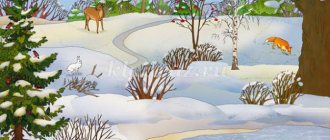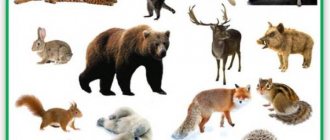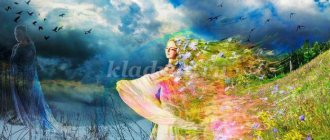Summary of GCD in the 2nd junior group: Wild animals
GCD in the second junior group of kindergarten
Objectives: Educational:
To consolidate children's knowledge about wild animals, their appearance, and the peculiarities of their habits.
Fix the names of the cubs. Specify the name of the dwelling. Consolidate knowledge about basic geometric shapes (circle, square, triangle); about the primary colors (red, blue, yellow, green) and shade - gray. Developmental:
Develop coherent dialogical speech, the ability to coordinate different parts of speech.
Develop attention, memory, thinking. Develop children's creative abilities; Ability to work neatly and cleanly with paints. Educational:
Foster love for the world around us;
Feeling of compassion, desire to help; Cultivate neatness and cleanliness. Equipment:
“Forest” decoration, supplies of squirrels and mushrooms. Slideshow on the projector “Inhabitants of the Forest” For each child, a landscape sheet with the image of a white hare, gray gouache paints, cotton swabs, napkins.
Progress of activities
V.: What a good day today, guests have come to us, let's say hello the way we know how: “Hello, palms - clap, clap, clap. Hello, legs - top, top, top. Hello, cheeks - splash, splash, splash. Round cheeks - splash, splash, splash. Hello, sponges - smack, smack, smack. Hello, teeth - click, click, click. Hello, my nose is bi, bi, bi. Hello, dear guests - hello. Mail: “Come urgently, help urgently! Miracles happen, we cannot divide the forest. The wizard scared us, he bewitched us all. We have forgotten who we are, what we should drink and what we should eat. Help us out, come and make peace between us urgently!” Forest inhabitants. Q: What are the names of the animals that live in the forest? (wild) Q: What wild animals do you know? Q: Why are they called wild? V.: some wizard bewitched all the animals, now they don’t know who they are, what they should eat, where to live, and most importantly, they don’t recognize their cubs. They ask us for help, shall we help? Q: But what can you use to go into the forest? Let's remember what types of transport we know. V.: They travel long distances by plane, the train travels on rails, they sail on the sea by ship, few people can fit in the car. Q: Are there many of us or few? Q: There are a lot of us, and the forest is not far, what can we all ride at the same time? V.: To go by bus, you need to buy tickets and sit in the place where the same figure of the same color is depicted (geometric shapes are glued to the chairs: a square, a circle and a triangle in red, yellow, blue and green colors) An inspector comes in and checks randomly tickets. The song “Bus” by V. sounds: it seems that we have arrived, listen to how the birds sing, how it smells in the forest. It’s very beautiful here, but I don’t see a single forest dweller. The animals are probably very confused, because they have forgotten who they are. 1 slide. Bear.
- who is this? -Tell me, children, what kind of bear is it? (big, brown,
kind, he has powerful paws, small ears) - what is the name of the cub? -What does he like to eat? - but in winter there is no honey and berries, what does the bear do? -Where does he sleep? 2 slide. Bear in a den.
V.: Oh, look, under the bush, under the bush there is Someone with a red tail. Who do you think it is? , 3rd slide Fox.
Q: Look at the fox and tell me what it is like. The fox is red, beautiful, cunning. She has a fluffy, long tail. She is often called plutovka, which means a deceiver. The fox does not change its coat; it is red both in summer and winter. -What is the name of the cub? 4 slide. Nora.
There is a fox's house under the bush. What is the name of the fox's house? V.: The entrance to the hole is narrow, long, and inside the hole is spacious and comfortable. Q: Who knows why the fox needs such a fluffy tail? (cover tracks) V.: let’s show together how a fox walks and covers its tracks. Physical exercise. The fox walked through the forest, made song calls, the fox tore the stripes, the fox wove bast shoes, walked near the Christmas tree, and what did you find on the Christmas tree? Mushrooms? Q: Do mushrooms grow on the Christmas tree? Q: What grows on the Christmas tree? (cones and needles)Where do mushrooms grow? (on the ground) V.: then whose mushrooms are these? (squirrel reserves) Where is the squirrel itself? 5 slide. Squirrel
V.: here she looks at us and asks for help, because she has forgotten who she is. Come on, guys, we'll tell you about her. What kind of coat does a squirrel have? (red, fluffy) Ears, tail? What is a baby squirrel called? (little squirrel) What is the name of her house? (hollow) 6 slide. Squirrel in a hollow.
V.: squirrels make themselves a house high in a tree. Let's show together how high it is. (We stand on our toes) Q: Why do you think the squirrel’s house is so high? (so that other animals cannot get to her or her supplies) V.: All animals have their own houses: the bear has a den, the fox has a hole, the squirrel has a hollow, but where does the hare live? What kind of house does he have? V.: The bunny doesn’t have a house, he slept under a bush and ran away, so he runs fast because there is nowhere to hide. Slide 7 The hare is white.
V.: Here is the bunny, let's look at it together. What kind of ears, tail, fur coat does he have? V.: The hare is a real fashionista: in winter he wears a white fur coat, and in summer he wears a gray one. Why do you think? (to make it easier to hide) Oh, trouble! It’s already spring, but the hare still hasn’t changed his coat, we need help. Painting a white hare gray (using the “poking” method with cotton swabs) 8 slide . The hare is gray.
V.: Look, the hare is already gray, we helped him. Great job guys, well done! Oh, he's already galloped away. Slide 9 Wolf
V.: Another resident showed up. Gray, scary and toothy. Caused a commotion. All the animals ran away. Scared the animals... V.: tell me what he is like? Slide 11 Lair.
V.: The wolf also has a home, look at what it is like. His home is called a lair. Sad music sounds and a wizard appears. V.: wizard, what happened, why are you so sad? Wizard: Yesterday I accidentally bewitched all the animals in the forest. I can’t cast the spell back - I forgot the words. V.: Don’t worry, wizard, we have already helped all the animals. We reminded them who they are, where they live and what they like to eat. V.: Guys, let's tell the wizard what animals we helped. Wizard: Thank you very much, you helped me out so much. Who are you and where did you come from? (from kindergarten) Wizard: what are you doing there? Show how you can dance. Dance “Stamp, my foot” Wizard: my time has come to please you. Close your eyes. The wizard says special words and a huge candy appears. Q: How can we share one candy among everyone? The wizard once again asks you to close your eyes, casts a spell, and many small ones appear from the large candy. The wizard thanks for the help and leaves. V.: oh, guys, it’s already very late, it’s time to go back. The bus ride will be long, so we will return to the group by plane. V.: they started the engines, spread their wings and flew.
We recommend watching:
Summary of GCD for children of the 2nd junior group on the topic: Winter Summary of GCD cognition using ICT in the 2nd junior group. Journey to the autumn forest Lesson notes. Walk through the forest. Senior group About animal houses for preschoolers
Similar articles:
Conversation about the hare for older preschoolers
What can you tell children about a hedgehog?
A story about a squirrel for 1st grade children on the world around them
What can you tell children about the fox?
Conversation about the wolf. Senior - preparatory group
Lesson notes for the second junior group “Wild Animals”
Lesson in the second junior group "Wild animals" Educator:
- Guys, a letter came to our group today, let's open it quickly.
The teacher opens the letter
- Hello, dear friends!
My name is Lisovichok. I would like you to know more about me Educator:
- Guys, it’s so interesting, would you like to know who Lesovichok is?
Children:
- Yes
The teacher reads the letter further
- To find out everything about me, you need to guess riddles, by doing this, you will find out where I live, who lives next to me
Teacher:
Guys, why should we solve riddles?
Children:
- Yes
Educator:
- Then listen to the first one. In the summer he walks without a road near the pines and birches, And in the winter he sleeps in a den, hiding his nose from the frost.
Children:
-Bear
Educator:
- That's right, it's a bear
Educator:
Guys, what does a bear look like?
Big, club-footed Children:
- Yes, the bear is big, club-footed, sleeps in the winter and walks through the forest in the summer.
Educator:
- Guys, tell me in which cartoons and fairy tales did you hear about a bear?
Children:
- Three bears, Masha and the bear, teremok, bun, Winnie the Pooh
Educator:
- Well done guys, show me how a bear walks
(Children show the bear's gait in order) Educator:
- Let's read the next riddle Fluffy tail, Golden fur, Lives in the forest, steals chickens in the village.
Children:
Fox
Educator:
- That's right, this is Fox
Educator:
Guys, what does a fox look like?
Children:
- Sly eyes, red hair, fluffy tail, narrow but long muzzle
Educator:
- Yes guys, you are right
Educator:
- In what cartoons and fairy tales can you find forests?
Children:
- Teremok, bun, fox and crane
Educator:
- Guys, show in a dream how a fox walks
(Children take turns showing the gait of a fox) Educator:
- Well done guys, we will read further Grayish, toothy, Prowls across the field, Looking for calves, lambs.
Children:
-Wolf
Educator:
-That’s right, it’s a Wolf - Guys, what does a wolf look like?
Children:
- Gray, a predator
Educator:
Well done guys, in what cartoons and fairy tales can you hear about a wolf?
Children:
- A wolf and seven kids, a little house, a bun
Educator:
Well done, shall we read the next riddle?
Children:
- Yes
Educator: -
The forests hide many troubles. There's a wolf, a bear and a fox! Our animal lives in anxiety, runs away from trouble... Well, quickly guess, what is the animal's name?
Children:
- Bunny
Teacher:
Well done guys, what does the bunny look like?
Children:
- Small, white in winter and gray in summer
Educator:
- That's right, in what cartoons and fairy tales can you hear about a bunny?
- Children:
Zayushkina's hut, little house
Educator:
That's right, show me how bunnies jump
(Children show how hares jump) Educator:
- Well done guys, guess all the riddles
Educator:
- Tell me, where do all these animals live?
Children:
- In the Forest
Educator:
- That's right, these are forest animals, which means these animals are wild
Children:
- They live in the forest and get their own food
Educator:
- Guys, remember Lesovichok said that he lives next to these animals.
So where does he live? Children:
- In the forest
Educator:
Well done guys, right
Game “Name the family”
Dad is a bear, mom is ... (mother bear), cub is ... (bear cub).
Dad is a wolf, mom is ... (she-wolf), cub is ... (wolf cub). Dad is a hedgehog, mom is ... (hedgehog), baby is ... (hedgehog). Dad is a hare, mom is ... (hare), baby is ... (bare). Dad is a fox, mom is ... (fox), cub is ... (fox). Physical exercise “Wild Animals”
Let’s get up, we need to rest, (Get up from the chairs) Shake our fingers.
(Clenching and unclenching your fingers) Raise your hands up, (Place your palms on your head with your fingers up) Move your fingers, (Move your palms forward and back) This is how little gray bunnies move their ears. We sneak quietly on our toes, (Walking in place on our toes, smooth, like foxes roaming through a forest. movements with our hands in front of us) The wolf looks around, (Hands on the belt, turns our heads And we turn our heads. left - right) Now we sit down more quietly, more quietly, (Squat down) Let's be quiet, like in a mouse hole. A bear walked through the forest, (Waddled, arms bent in front of him, stomped and growled. Elbows) He really wanted honey, But he didn’t know where to get it. (Raise your shoulders up, make a questioning look) Educator:
- Well done guys, who did we talk about today?
Why do we call them wild? Educator:
Well done guys, today you guessed the riddles correctly and answered the questions





